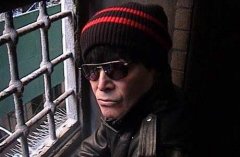Alan Vega
Suicide disbanded in 1980, and both Vega and Rev undertook solo careers. Vega's self-titled 1980 debut and his 1981 effort Collision Drive continued to explore the fractured rockabilly identity he had established in his earlier work. 1983's Saturn Strip, produced by long-time fan Ric Ocasek, marked Vega's debut for Elektra Records; corporate relations soured during production for 1985's Just a Million Dreams, however, and at one point the label even attempted to remove the singer from his own studio sessions.
Suicide briefly reformed in 1988; a year later the solo Vega appeared, followed in 1990 by Deuce Avenue. After the release of 1991's Power On to Zero Hour, Suicide again reunited and toured. In 1995, Vega resurfaced as a solo artist with New Raceion; a year later, he returned with Dujang Prang. At the turn of the decade, he also began exploring new media outlets; Deuce Avenue War/The Warriors v3 97, his first book of photography, appeared in 1990, while Cripple Nation, a collection of prose and lyrics, bowed in 1991. - All music.com
Vega has since collaborated with people such as Bobby Gillespie, Mercury Rev and Death in Vegas to name a few.
